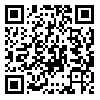Volume 23, Issue 70 (9-2023)
jgs 2023, 23(70): 455-486 |
Back to browse issues page
Download citation:
BibTeX | RIS | EndNote | Medlars | ProCite | Reference Manager | RefWorks
Send citation to:



BibTeX | RIS | EndNote | Medlars | ProCite | Reference Manager | RefWorks
Send citation to:
Momenian Najjar A, Mirgholami M, Oskoyi A. (2023). Quantitative and qualitative meta-analysis of Scientific Research Papers in the field of creative city in Tehran metropolis. jgs. 23(70), : 24 doi:10.61186/jgs.23.70.455
URL: http://jgs.khu.ac.ir/article-1-4159-en.html
URL: http://jgs.khu.ac.ir/article-1-4159-en.html
1- Tabriz Islamic Art University, Department of Architecture and Urban Planning, Tabriz Islamic Art University , Hakim Nezami Sq., Azadi St., Tabriz, Postal Code: 5164736931,
2- Tabriz Islamic Art University, Department of Architecture and Urban Planning, Tabriz Islamic Art University , Hakim Nezami Sq., Azadi St., Tabriz, Postal Code: 5164736931, ,m.mirgholami@tabriziau.ac.ir
2- Tabriz Islamic Art University, Department of Architecture and Urban Planning, Tabriz Islamic Art University , Hakim Nezami Sq., Azadi St., Tabriz, Postal Code: 5164736931, ,
Abstract: (5410 Views)
One of the new theories in the field of urban development planning is the creative city theory, which can be useful due to the intense competition between cities in the age of globalization. Based on this, various researches have been done about the metropolis of Tehran, which have looked at the city of Tehran and creativity from different angles. Therefore, analysis and evaluation of these researches from different aspects such as study scale, research method and results are necessary. The purpose of this study is to systematically review the articles on the subject of creative city in Tehran in order to identify research shortcomings and also the systematic combination of their valuable results. This research uses both quantitative and qualitative methods in the form of systematic review. For this purpose, it uses quantitative and qualitative meta-analysis. Preliminary research data consists of thirteen Scientific Research Papers that have been selected using purposive sampling. Findings from a quantitative review of articles show that most of the research conducted in the field of creative cities is quantitative, positivist, non-exploratory, large-scale and pays little attention to indigenous indicators. Also, the qualitative results of the research indicate that the city of Tehran, despite its relative position in terms of creative city indicators in the country, is far from international standards and existing trends do not show the move to a creative city. In order to achieve the creative city of Tehran, it is necessary to consider following points; at the international level the principles of competition and interaction, at the national level the principle of balance, at the level of Tehran metropolis the principle of development, at the city zones the principle of spatial justice and at the level of neighborhoods and urban spaces the principles of the quality of space and vitality.
Article number: 24
Type of Study: Research |
Subject:
Geography and Urban Planning
Send email to the article author
| Rights and permissions | |
 |
This work is licensed under a Creative Commons Attribution-NonCommercial 4.0 International License. |

This work is licensed under a Creative Commons — Attribution-NonCommercial 4.0 International (CC BY-NC 4.0)






